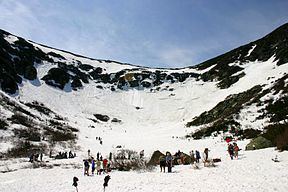Floor elevation 4,430 ft (1,350 m) | ||
 | ||
Similar Mount Washington, Pinkham Notch, Huntington Ravine, Boott Spur, Wildcat Mountain Ski Area | ||
Insane steep skiing at tuckerman ravine season pass
Tuckerman Ravine is a glacial cirque sloping eastward on the southeast face of Mt. Washington, in the White Mountains of New Hampshire. Although it draws hikers throughout the year, and skiers throughout the winter, it is best known for the many "spring skiers" who ascend it on foot and ski down the steep slope from early April into July. In this period, the temperatures are relatively mild but the natural snowpack — which averages up to 55 feet (17 m) in a typical winter — is still adequate to ski most seasons. The record-setting high winds atop Mount Washington scour a massive amount of snow from the surrounding highlands and drop it here or in the adjacent Huntington Ravine.
Contents
- Insane steep skiing at tuckerman ravine season pass
- Map of Tuckerman Ravine Sargents Purchase NH 03846 USA
- Tuckerman ravine jumping headwall
- Anatomy of the BowlEdit
- HistoryEdit
- References
Map of Tuckerman Ravine, Sargent's Purchase, NH 03846, USA
Thousands of people have been known to ski Tuckerman in a single spring weekend. Skiing is not limited to this time, but the avalanche danger, peaking from late December to early March, requires special training and experience to assess and navigate the ravine safely during the winter. Avalanches have killed at least 10 people in the ravine since the 1960s.
The ravine is most easily accessed from the AMC lodge on Route 16 at Pinkham Notch, via the moderate 2.4-mile (3.9 km) lower section of the Tuckerman Ravine Trail. This trail is maintained in winter and spring as a "cat" trail, and parallels the Sherburne Trail used for ski and snowboard descents. It is a 1,850-foot (560 m) elevation drop from the foot of Tuckerman to the lodge.
Tuckerman ravine jumping headwall
Anatomy of the BowlEdit
Tuckerman Ravine has many different runs that span the bowl, all as steep as 40 to 55 degrees. From the base of the bowl, the run farthest to the left is known simply as "Left Gully" and is one of the easiest runs. Moving to the right, the runs are more challenging and steeper. More to the right, "The Chute" drops between two large cliffs that slowly narrow the run. Still farther to the right are the Center Gullies, which includes "The Icefall", which is 55 degrees, and requires skiers to go off cliffs as tall as 25 feet (7.6 m). Right of the "The Icefall" is "The Lip". It is an open run that averages between 50 and 55 degrees. "Right Gully", one of the bowl's easier runs, drops into "The Sluice" about halfway down, and averages about 40 degrees.
HistoryEdit
The ravine is named after botanist Edward Tuckerman who studied alpine plants and lichens in the area in the 1830s and 1840s. According to the New England Ski Museum, the first recorded use of skis on Mount Washington was by a Dr. Wiskott of Breslau, Germany, who skied on the mountain in 1899, while the first skier in Tuckerman was John S. Apperson of Schenectady, New York, in April 1914. According to the Mount Washington Avalanche Center, the first known death associated with the bowl is a 15-year-old "killed by falling ice" on July 24, 1886; the first recorded death associated with icefall was in January 1936; the first death associated with falling into a crevasse was in June 1940; and the first skiing-related death was in April 1943.
Races held in the 1930s attracted large groups of spectators and skiers. Harvard-Dartmouth slaloms, Olympic tryouts, and giant slaloms all were held in the ravine in that decade. But the races that caught the imagination more than any other, the races that still are talked about by Tuckerman skiers, were the three American Infernos of the 1930s.
Just two years after the headwall was first run on April 11, 1931 by Dartmouth men John Carleton and Charles N. Proctor, the Ski Club Hochgebirge proposed a 4.2-mile summit-to-base race on Mt. Washington, to be called the American Inferno, named for a similar race held in Mürren, Switzerland. The American Inferno races were only run in 1933, '34 and most famously on April 16, 1939. A shortened course was run in the spring of 1952 (because of a cloud-shrouded summit) that started just above the Lip of the Headwall, and was won by Dartmouth's Bill Beck. The races featured famous skiers like Dick Durrance ('34 and '39), Brooks Dodge ('52) and Toni Matt ('39), who accidentally straight-lined the steep headwall for the win, a still-impressive achievement.
